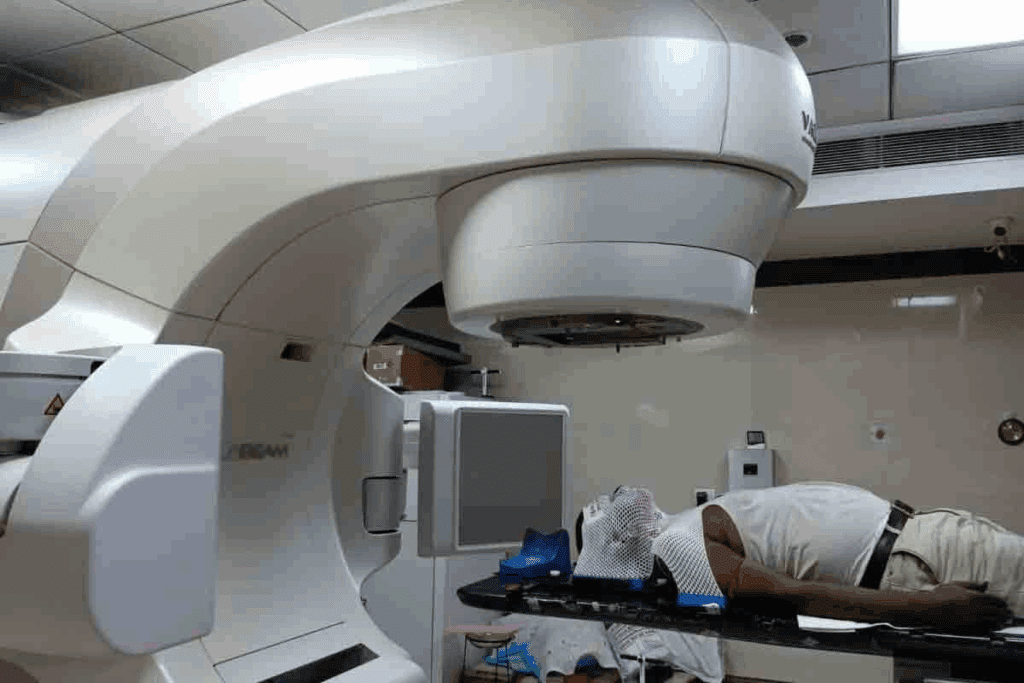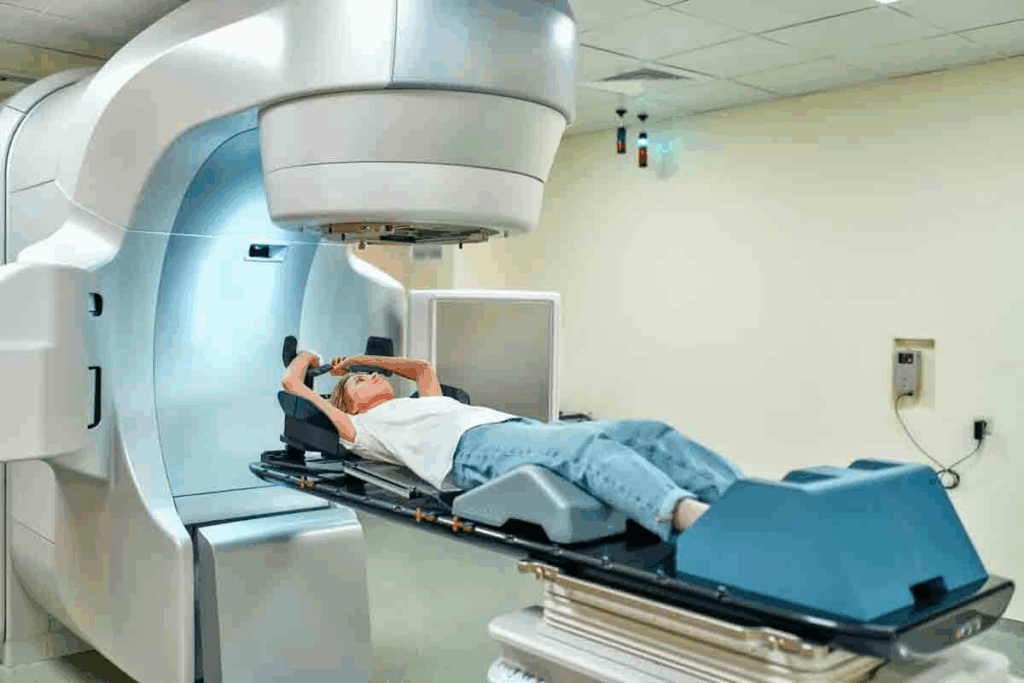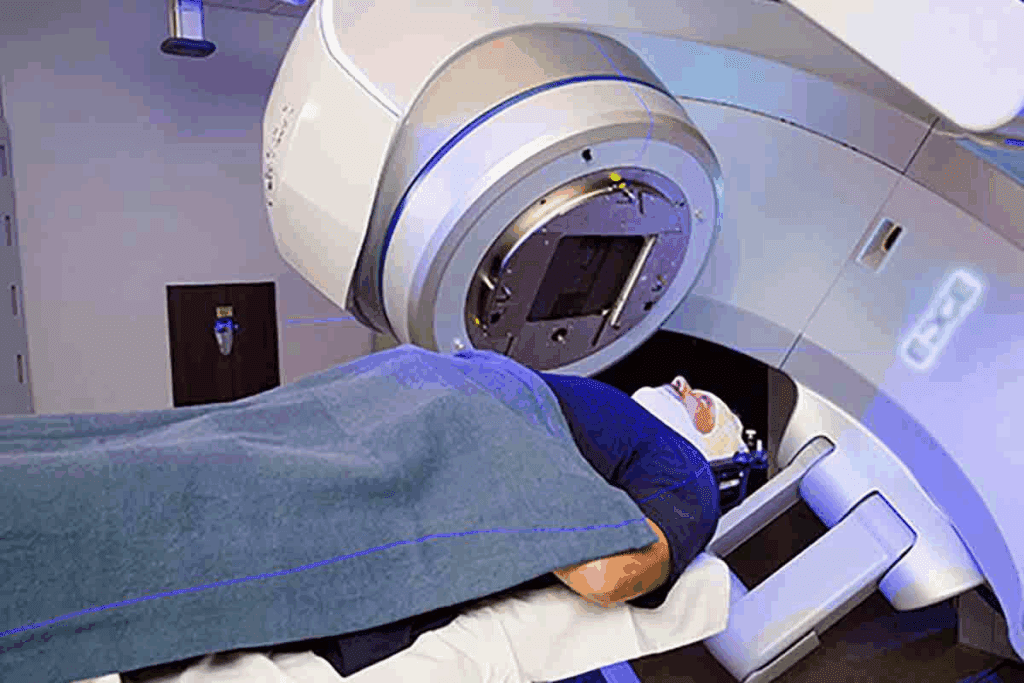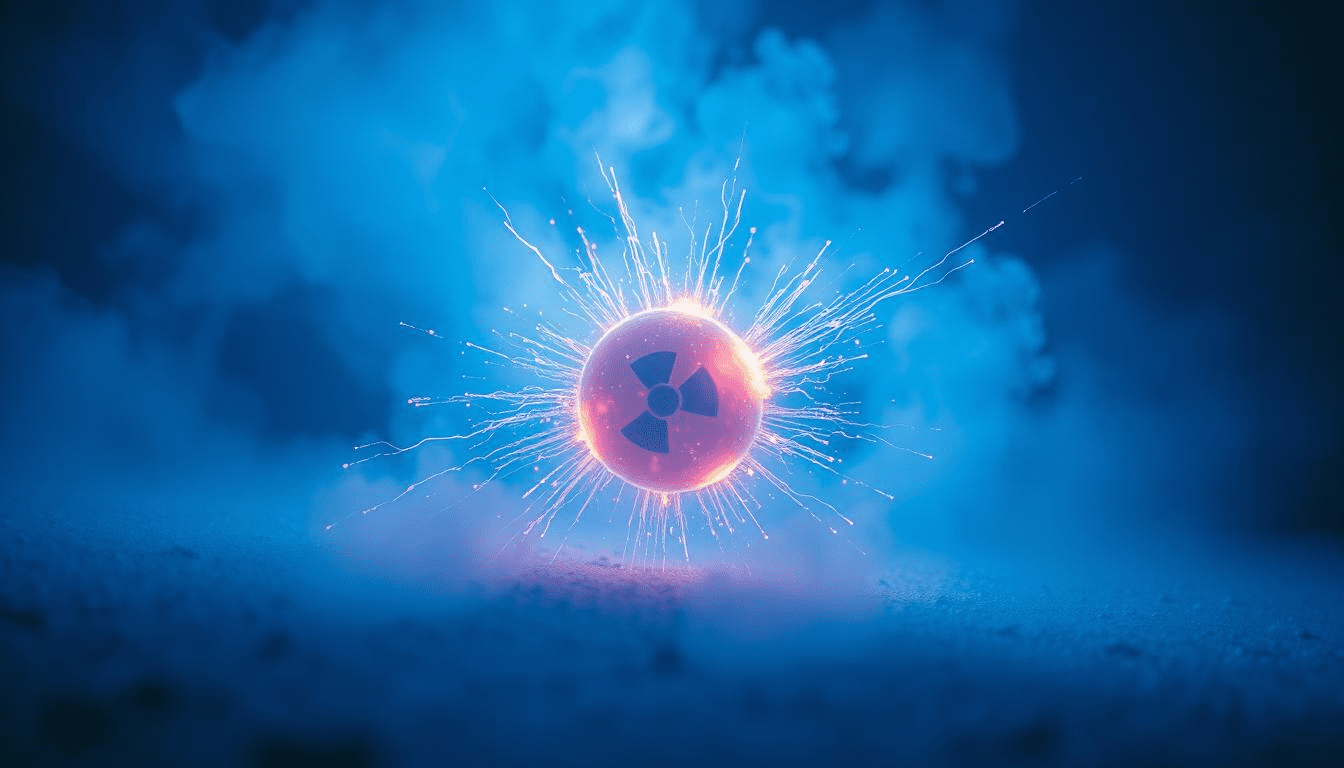Last Updated on November 27, 2025 by Bilal Hasdemir

At Liv Hospital, we use a precise and trusted cancer treatment called brachytherapy or internal radiation therapy. This method puts radioactive materials right into or near cancerous tissues. It kills cancer cells while protecting healthy tissue.
This way, we target the tumor directly. We give a high dose of radiation to kill cancer cells. This method is great for many cancers, like prostate, breast, cervical, and uterine cancers.
Key Takeaways
- Brachytherapy involves placing radioactive materials directly into or near cancerous tissues.
- This technique allows for a high, localized dose of radiation to destroy cancer cells.
- It minimizes harm to surrounding healthy tissue, reducing side effects.
- Brachytherapy is effective for treating various types of cancers.
- Liv Hospital utilizes this innovative approach to provide world-class cancer care.
Understanding Internal Radiation Therapy

Internal radiation therapy, also known as brachytherapy, is a cancer treatment. It involves placing radioactive material inside the body. This method delivers high doses of radiation directly to the tumor, reducing damage to healthy tissues.
Definition and Basic Principles
Brachytherapy uses small, sealed radioactive sources, like seeds, wires, or capsules. These are placed near or inside the tumor. The radiation damages the DNA of cancer cells, stopping them from dividing and leading to cell death.
The goal of brachytherapy is to target the tumor with radiation while protecting healthy tissues. This is done by carefully placing the radioactive material and planning the radiation dose.
Historical Development of Brachytherapy
Brachytherapy began in the early 20th century, after Marie Curie discovered radium. At first, radium was used for brachytherapy. But with the creation of artificial radionuclides, the treatment became safer and more available.
Technology has greatly improved brachytherapy over the years. Today, it uses advanced imaging like ultrasound and MRI for precise placement. Computer systems also help in calculating the best radiation doses for treatment.
| Period | Advancements in Brachytherapy |
| Early 20th Century | Initial use of radium for brachytherapy |
| Mid-20th Century | Development of artificial radionuclides for safer treatments |
| Late 20th Century | Introduction of imaging techniques like ultrasound and MRI for precise placement |
| 21st Century | Advancements in computerized treatment planning for optimized radiation doses |
How Internal Radiation Therapy Works

Internal radiation therapy places radioactive sources in or near tumors. This method, called brachytherapy, is key in fighting cancer. It targets and kills cancer cells effectively.
The Science Behind Radiation and Cancer Cells
Radiation therapy harms cancer cells by damaging their DNA. This stops them from growing and dividing. Internal radiation therapy sends this radiation right to the tumor. This way, cancer cells get a lot of radiation, but healthy tissues nearby get less.
Radioactive materials implanted in tissues send out radiation that only goes a short way. This targeted delivery helps avoid the side effects of other radiation treatments.
“Brachytherapy allows for the delivery of high doses of radiation to specific areas, making it an effective treatment for various types of cancer.”
— Senior Oncologist
Targeted Delivery of Radiation
The success of internal radiation therapy relies on where the radioactive materials are placed. We use advanced imaging to find the tumor’s exact location and size.
We use different ways to get radiation to the tumor, like permanent or temporary implants. The choice depends on the cancer type, its stage, and the patient’s health.
Radiation Dosage and Distribution
Finding the right amount of radiation is key to effective treatment. The dosage depends on the tumor’s size and type, and the patient’s health.
| Cancer Type | Typical Radiation Dosage | Distribution Method |
| Prostate Cancer | 140 Gy | Permanent Seeds |
| Cervical Cancer | 80-90 Gy | Temporary Implants |
| Breast Cancer | 30-40 Gy | Temporary Implants |
We plan the radiation dosage and how it’s spread out carefully. This makes the treatment more effective and reduces side effects.
Types of Internal Radiation Therapy
Internal radiation therapy comes in different forms, each suited for different patients and cancers. The right choice depends on the cancer type, stage, and the patient’s health.
Permanent Implants (Seeds)
Permanent implants, or “seeds,” are tiny radioactive particles placed near tumors. They stay in the body, slowly releasing radiation until they lose their radioactivity. These implants give a steady, low dose of radiation to cancer cells. They’re often used for prostate cancer.
The American Cancer Society notes, “For men with early-stage prostate cancer, brachytherapy alone may be used as the primary treatment.”
“Brachytherapy can be an effective treatment for prostate cancer, with a high cure rate for early-stage disease.”
Temporary Implants
Temporary implants involve placing radioactive material in the body for a short time before it’s removed. They deliver a higher dose of radiation in a shorter time than permanent implants. The implant’s duration can range from minutes to days, depending on the plan. They’re used for cancers like gynecological and head and neck.
Temporary implants offer flexible treatment plans, allowing for adjustments as needed. A study in the Journal of Clinical Oncology found, “Temporary brachytherapy implants have shown significant efficacy in treating various types of cancer with minimal side effects.”
Both permanent and temporary implants have their roles in cancer treatment. The choice depends on the patient’s specific case, considering cancer type, stage, and health. We work with patients to find the best internal radiation therapy for them.
Radioactive Materials Used in Internal Radiation Therapy
Internal radiation therapy works well because of the special radioactive isotopes used. These isotopes are picked for their unique traits and the cancer type they treat. We use different radioactive materials for various cancers, each with its own benefits.
Common Isotopes and Their Properties
In brachytherapy, we often use Iodine-125, Palladium-103, Cesium-131, and Iridium-192. Iodine-125 is great for prostate cancer because it lasts about 59.4 days. This long half-life means it can keep giving off radiation for a while.
Palladium-103 has a shorter half-life of about 17 days. It’s also for prostate cancer, but it gives a stronger dose at first.
Cesium-131 lasts 9.7 days and treats many cancers, like brain and lung tumors. It has a moderate energy level. Iridium-192 is known for its strong gamma radiation. It’s used in temporary implants for cancers like breast, prostate, and gynecological ones.
Selection Criteria for Different Cancers
Choosing the right radioactive isotopes for brachytherapy is key. We look at the cancer type, tumor size and location, and the patient’s health. We consider the isotope’s half-life, energy, and if it’s for a permanent or temporary implant.
- Half-life: Shorter half-lives mean quicker radiation, while longer ones last longer.
- Energy Emission: The isotope’s energy level affects how deep it can penetrate and damage cancer cells.
- Tumor Characteristics: The tumor’s size, location, and how aggressive it is also play a role in choosing the isotope.
By picking the right radioactive material, we make internal radiation therapy more effective and reduce side effects.
Cancer Types Commonly Treated with Internal Radiation
We use internal radiation therapy to treat many cancers. It’s a precise and effective treatment. Brachytherapy is key in managing different cancers. It targets the tumor with little harm to healthy tissues.
Prostate Cancer Treatment
Brachytherapy is a top choice for prostate cancer, mainly for early-stage disease. It involves placing radioactive seeds in the prostate. This method gives high doses of radiation to the tumor while protecting other tissues.
Benefits of brachytherapy for prostate cancer include:
- High efficacy rates for localized cancer
- Minimally invasive procedure
- Reduced risk of incontinence and impotence compared to surgery
Gynecological Cancers (Cervical, Uterine)
Internal radiation therapy is also a key treatment for gynecological cancers. This includes cervical and uterine cancer. Brachytherapy is used with external beam radiation to boost the tumor dose.
| Cancer Type | Brachytherapy Application | Benefits |
| Cervical Cancer | Intracavitary brachytherapy | High local control rates, preservation of surrounding tissues |
| Uterine Cancer | Intracavitary or interstitial brachytherapy | Effective for early-stage disease, reduced risk of complications |
Breast Cancer Applications
Brachytherapy is used in breast cancer treatment, mainly for early-stage disease. It can be used as a boost after whole-breast irradiation or as partial breast irradiation (PBI) for some patients.
Advantages of brachytherapy in breast cancer include:
- Shorter treatment duration compared to traditional whole-breast radiation
- Reduced exposure to surrounding healthy tissues
- Effective for early-stage breast cancer
Head and Neck Cancers
Internal radiation therapy is used in head and neck cancer treatment. It’s often combined with external beam radiation and surgery. Brachytherapy is great for tumors in hard-to-reach areas.
Brachytherapy is a versatile and effective treatment for many cancers. It delivers radiation directly to the tumor, reducing damage to healthy tissues. This improves outcomes and lowers side effects.
The Internal Radiation Therapy Procedure
The brachytherapy procedure is a detailed and effective cancer treatment. It needs careful planning and execution. Knowing the process can help patients feel more comfortable.
Pre-Treatment Planning and Imaging
Before starting, we do a lot of planning. We use CT scans, MRI, or ultrasound to find the tumor. This helps us plan where to put the radioactive sources.
Our team uses special software to make a detailed plan. This plan makes sure the radiation dose is just right for the patient.
We also check the patient’s health and any risks during this time. This helps us reduce side effects and make the treatment more effective.
Implantation Process
Next, we put radioactive materials into or near the tumor. This can be done in different ways, like using seeds or temporary implants. Our team uses imaging to place them accurately.
The procedure is done under local anesthesia or sedation to make it less painful. The method used depends on the cancer type and the patient’s needs.
Duration and Treatment Sessions
The length of internal radiation therapy varies. It depends on the cancer type, stage, and treatment plan. Some patients get one session, while others need several over time.
For temporary implants, the material stays in for a few minutes to days. Permanent implants have seeds that stay in but lose radioactivity over time.
Our team watches the patient’s progress closely. We adjust the plan as needed to get the best results.
Effectiveness and Success Rates of Internal Radiation
Internal radiation therapy is a top choice for treating many cancers. We’ll look at how well brachytherapy works for different cancers. We’ll also talk about what makes it successful and how it’s used with other treatments.
Clinical Outcomes by Cancer Type
Brachytherapy works well for some cancers. For example, it’s very effective for prostate cancer. Studies show it helps control cancer and improve survival rates. It’s also used for gynecological cancers, like cervical and uterine cancers, often with other radiation treatments.
Brachytherapy’s success comes from its ability to target tumors closely. This reduces harm to healthy tissues. Here are some key outcomes by cancer type:
- Prostate Cancer: High rates of cancer control and survival
- Gynecological Cancers: Effective in treating cervical and uterine cancers
- Breast Cancer: Used in accelerated partial breast irradiation (APBI) for early-stage breast cancer
- Head and Neck Cancers: Employed in treating various head and neck malignancies
Factors Affecting Treatment Success
Many things affect how well brachytherapy works. These include the cancer’s stage and type, the patient’s health, and the brachytherapy method. Early-stage cancers do better because the tumor is smaller and easier to hit. The patient’s health is also key, as better health leads to better results.
The skill of the brachytherapy team is also important. A well-planned and precise treatment can greatly improve outcomes.
Combination with Other Therapies
Brachytherapy is often paired with other treatments like external beam radiation therapy (EBRT) and chemotherapy. This combo boosts treatment effectiveness. EBRT covers more area, while chemotherapy makes cancer cells more sensitive to radiation.
The choice of treatments depends on the patient and their cancer. This approach aims to treat cancer fully and effectively.
Safety Measures and Brachytherapy Precautions
When you get internal radiation therapy, safety is key for patients, caregivers, and doctors. It’s important to make sure brachytherapy is given safely. This protects everyone from radiation.
Radiation Protection for Patients
Patients get radioactive materials during brachytherapy. They need special safety steps. Radiation protection for patients means careful planning and watching. This makes sure the radiation goes only to the tumor, not healthy tissues.
We use customized radiation shields and precise dosimetry. This helps control how much radiation is given.
Guidelines for Caregivers and Family
Caregivers and family are important for patients getting brachytherapy. We give them rules to stay safe from radiation. These rules include not staying too close, keeping a safe distance, and following hygiene rules.
- Limit close contact to short periods
- Maintain a safe distance from the patient
- Follow hospital guidelines for hygiene and safety
Hospital Safety Protocols
Hospitals have strict safety rules for handling radioactive materials. These rules protect staff, patients, and visitors. They include regular radiation monitoring, proper storage and disposal, and training for healthcare workers.
Following these safety steps and precautions helps reduce risks in brachytherapy. It makes sure a safe place for treatment for everyone.
Side Effects and Management
Brachytherapy is a powerful cancer treatment, but it can have side effects. We’ll explain what these effects are and how to deal with them. This will help make your treatment better.
Short-Term Side Effects
Brachytherapy’s short-term side effects depend on where the radiation is placed and how much is used. You might feel tired, have skin issues at the implant site, or feel pain. For example, prostate cancer patients might have trouble with their urine.
To handle these issues, try the following:
- Rest well to fight fatigue
- Use creams or ointments for skin problems
- Follow your doctor’s advice for pain relief
Long-Term Considerations
Long-term side effects can show up months or years later. These might include changes in how you use the bathroom or issues with sex. It’s important to talk to your doctor about these risks and how to manage them.
For more info on managing side effects, check out the National Cancer Institute’s page on radiation therapy side effects.
Managing Radiation-Related Symptoms
Managing symptoms related to radiation is key to a better life during and after treatment. This means catching symptoms early and making lifestyle changes to lessen the treatment’s impact.
| Symptom | Management Strategy |
| Fatigue | Regular rest, gentle exercise, and a balanced diet |
| Skin Reactions | Topical treatments and gentle skin care |
| Urinary Symptoms | Medications to alleviate symptoms, dietary adjustments |
Knowing about brachytherapy’s side effects and how to manage them helps patients through their treatment. We’re here to support you from start to finish.
Recovery and Aftercare Following Internal Radiation
Recovering from internal radiation therapy involves several steps. These include monitoring, activity limits, and a follow-up plan. Understanding these steps is key to a smooth recovery.
Post-Treatment Monitoring
Patients need close watch after internal radiation therapy. This helps check how well the treatment is working and manage side effects. Monitoring includes:
- Regular visits to your healthcare provider to check on the treatment’s success and address any issues.
- Imaging tests, like ultrasound or MRI to see how the treated area is doing.
- Blood tests to keep an eye on blood cell counts and overall health.
It’s important to keep all follow-up appointments to track your recovery.
Activity Restrictions and Guidelines
Following certain rules helps ensure a safe recovery. These rules might include:
- Staying away from heavy lifting, bending, or hard work for a while.
- Practicing good hygiene to lower infection risk.
- Following diet advice to help your health and recovery.
Your healthcare team will give you specific advice based on your needs and treatment.
Follow-up Care Schedule
A follow-up plan is a big part of recovery. It’s made just for you and might include:
- First follow-up visits should be soon after treatment.
- Regular check-ups every few months to see how you’re doing.
- Long-term follow-ups to check how long the treatment lasts.
Sticking to this plan is important to catch and fix any problems early.
Conclusion: The Future of Internal Radiation Therapy
Internal radiation therapy, or brachytherapy, is a key treatment for many cancers. It sends radiation right to the tumor, reducing harm to healthy tissues. This makes it a targeted and often less invasive option for patients.
The future of brachytherapy looks bright, thanks to ongoing research and tech advancements. New imaging and dosimetry tools are making treatments more precise. Also, new radioactive isotopes and delivery systems are opening up brachytherapy to more cancer types.
As brachytherapy evolves, we’ll see more tailored treatments. It’s being combined with other cancer treatments like chemotherapy and immunotherapy. This could bring new hope to patients with complex or advanced cancers. With these advancements, the future of brachytherapy is full of promise for better patient care and outcomes.
FAQ
What is internal radiation therapy?
Internal radiation therapy, also known as brachytherapy, is a cancer treatment. It involves placing radioactive materials directly into or near the tumor. This helps destroy cancer cells while protecting healthy tissues nearby.
How does internal radiation therapy work?
This therapy works by placing radioactive materials close to the tumor. These materials release radiation that damages cancer cells’ DNA. This stops them from growing and dividing.
What are the types of internal radiation therapy?
There are two main types. Permanent implants, like seeds, stay in the body and keep emitting radiation. Temporary implants are removed after a set time.
What cancers are commonly treated with internal radiation therapy?
It’s used for many cancers. These include prostate, gynecological, breast, and head and neck cancers.
What are the common isotopes used in internal radiation therapy?
Common isotopes include Iodine-125, Palladium-103, Cesium-131, and Iridium-192. The choice depends on the cancer type and stage.
What are the side effects of internal radiation therapy?
Side effects can include fatigue, urinary problems, and radiation symptoms. The severity and how long they last vary by person and cancer type.
How is internal radiation therapy administered?
It’s administered through a procedure. This involves planning and imaging, followed by the placement of radioactive materials. The process is done under local anesthesia or sedation.
What are the safety precautions for internal radiation therapy?
Safety measures include protecting patients from radiation. There are also guidelines for caregivers and family members. Hospitals follow protocols to reduce radiation exposure.
What is the recovery process like after internal radiation therapy?
Recovery involves monitoring and activity restrictions. Patients are told when they can resume normal activities. They also need to follow up with care to track their progress.
Can internal radiation therapy be used in combination with other therapies?
Yes, it can be used with other treatments. This includes external beam radiation, chemotherapy, or surgery. It aims to achieve the best treatment results.
What are the benefits of internal radiation therapy?
It delivers a high dose of radiation directly to the tumor. This minimizes damage to healthy tissues and reduces side effects.
How effective is internal radiation therapy?
It’s a highly effective treatment for many cancers. Outcomes vary based on cancer type, stage, and individual factors.
What is the difference between sealed radiation implant and internal radiotherapy treatment?
Sealed radiation implant and internal radiotherapy are terms for brachytherapy. They refer to placing radioactive material inside or near the tumor.
Are there any specific precautions to be taken after being discharged following internal radiation therapy?
After discharge, patients and caregivers should follow guidelines. This includes avoiding close contact with pregnant women and young children to minimize radiation exposure.
References:
- Kim S, Holder DL, Laymon CM, et al. SPECT Imaging of Epilepsy: An Overview and Comparison with F-18 FDG PET. International Journal of Molecular Imaging. 2011;2011:813028. https://pmc.ncbi.nlm.nih.gov/articles/PMC3139140/
- Prener M, Drejer V, Ziebell M, et al. Ictal and interictal SPECT with 99mTc‐HMPAO in presurgical epilepsy. I: Predictive value and methodological considerations. Epilepsia Open. 2023;8(4):1064–1074. https://pmc.ncbi.nlm.nih.gov/articles/PMC10472396/






